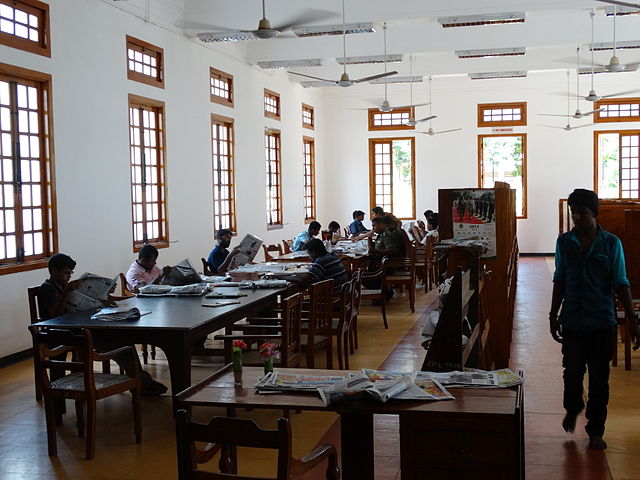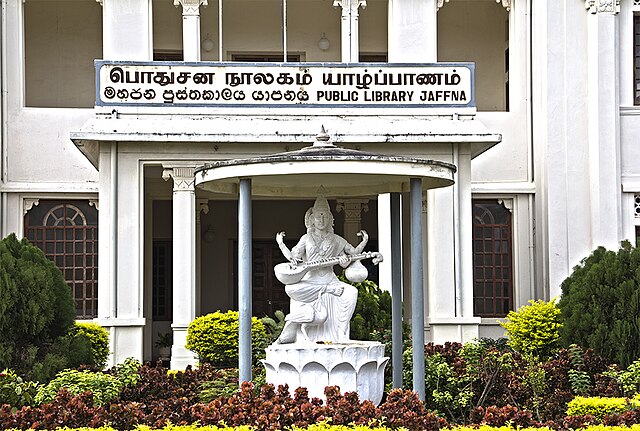
Jaffna Public Library, Sri Lanka
Jaffna Public Library (JPL) is in Jaffna, the capital city of the Northern Province of Sri Lanka. It was built in 1933 and is noted for its attractive architecture and gardens. The building’s style was inspired by Dravidian architecture of South India, featuring temples with towers in the form of pyramids. As the archivist Sundar Ganesan, director of the Roja Muthiah Research Library in Chennai, explained in Himal Magazine in 2014, in 1933 K. M. Chellappah, an employee of the district court in Jaffna, suggested that there was the need for a central free Tamil library in Jaffna. He tirelessly discussed the idea with workers, unions, teachers, writers, and business people, asking for their support. The library would be planned to hold books in Tamil and other languages. The first library opened in 1934 in a rented building, holding over 800 books and 30 periodicals. Its advisor was Siyali Ramamrita Ranganathan (S.R.R.), a mathematician and librarian from India considered to be the father of library science, documentation, and information science in India. In India, S.S.R.’s birthday is observed annually as National Library Day. S. S. R. is especially celebrated for his five laws of library science, formulated in 1931:
- Books are for use.
- Every reader his / her book.
- Every book its reader.
- Save the time of the reader.
- The library is a growing organisation.
Further assistance and advice came from the Jaffna Library Society, along with the British Library and the Delhi University Library. A permanent new library building opened in 1959, with funds raised through lotteries, carnivals and plays. By 1960, the library had 16,000 books, magazines in Tamil and English, and manuscripts. These included early colonial accounts of Ceylon and works about The Tolkāppiyam, a work on the grammar of the Tamil language and the earliest extant work of Tamil literature and linguistics. 33 library staff assisted over 17,000 library members. Unfortunately, local strife resulted in the library being burned in 1981. Over 95,000 ola leaf manuscripts, written on palm leaves, parchments, books, magazines and newspapers were destroyed. Only several years later was the building finally restored, although its collections were permanently lost. It reopened in 2003. Dr. Sundar reported on a trip to the area in 2002:
When I visited some smaller branches and collections in Jaffna, the locals’ enthusiasm for the library seemed undiminished despite the tragedy. Every branch was full of young boys and girls, fully engaged in their daily reading. Outside, large numbers of bicycles crowded the stands. When I enquired, the librarians said that people were serious about their reading, and visited their local library every day to read newspapers, magazines and books. Back in India, I started collating information on other libraries that had been set on fire or vandalised. Generally, libraries are targeted as symbols of cultural identity and patrimony. That was – and still is – especially true in the case of the JPL. Torching such an important intellectual and cultural resource was a clear attempt to erase the cultural memory of an ethnic and linguistic group. The tragedy in Sri Lanka is particularly acute, with memories of the destruction of the library still fresh in the minds of the Tamil community…
Although the BBC reported on a disturbance in the restored library in 2010, America’s National Public Radio explained in 2015 that the library was active, growing, and offering its users free WiFi access.

Thailand and Sri Lanka
In February, The Bangkok Post mentioned that Thailand and Sri Lanka plan to sign a free trade agreement (FTA) later this year. The aim would be to triple bilateral trade to US$1.5 billion (52.5 billion baht) over the next five years. Negotiations have been underway for a while. Last April, Associated Newspapers of Ceylon described that talks had begun again in earnest for an FTA between the two countries. There have also been efforts to promote Sri Lanka as a destination for Thai tourists. At the Sri Lanka-Greater Mekong Subregion Business Council’s fifth annual general meeting held at the Hilton Colombo Residencies, His Excellency Mr. Nopporn Adchariyavanich, Ambassador of the Kingdom of Thailand to Sri Lanka, stated:
More than 70,000 Sri Lankan tourists visit Thailand every year because much publicity is being given in the Sri Lankan media, especially newspapers and magazines, to Thailand. However, when it comes to Thai newspapers, very few articles are written on Sri Lanka’s tourist destinations.
The ambassador suggested that several sites of touristic interest in Sri Lanka might appeal to Thai travellers, who remain underinformed about them. These include the Sacred City of Anuradhapura, a UNESCO World Heritage site established around a cutting from the tree of enlightenment, the Buddha’s fig tree, brought there by the founder of an order of Buddhist nuns. Another likely place of interest is the Ancient City of Polonnaruwa, second capital of Sri Lanka after the destruction of Anuradhapura in the year 993. It contains monumental ruins of a garden-city created before the year 1200. It too is a UNESCO World Heritage site, as is the Ancient City of Sigiriya a rock fortress located in the northern Matale District of the Central Province, Sri Lanka. A palace built on the top of a rock was with frescoes. It was used as a Buddhist monastery until the 1300s. It is considered one of the best-preserved examples of ancient urban planning. Instead of these places, Thai tourists tend to go to Sri Dalada Maligawa or the Temple of the Sacred Tooth Relic, a Buddhist temple in the city of Kandy, Sri Lanka. The fame of this famous pilgrimage site ensures that it receives many tourists each year. His Excellency Ambassador Nopporn added that Thailand and Sri Lanka could develop exchanged in
agriculture, fisheries, construction, tourism and consumer products, which have a great potential to improve trade and investment between the countries.

Other exchanges
Last year, an International Symposium on the Conservation of Brick Monuments at World Heritage Sites was held Ayutthaya. It united international experts in archaeology and conservation from Thailand, Sri Lanka, and many other countries. The symposium was co-organized by the Fine Arts Department and studied how best to preserve the brick monuments of Ayutthaya. These and other ventures are echoed in a book newly acquired by the Thammasat University Libraries. 60th Anniversary Diplomatic Relations between Thailand and Sri Lanka commemorates the anniversary in 2015 of the establishment of diplomatic relations between the two countries. That year, H.E. Ambassador Nopporn visited H.E. Mr. Maithripala Sirisena, the President of Sri Lanka and observed
that Thailand and Sri Lanka have had a long history of close religious relations more than 800 years. Buddhism has played an important role in binding the two countries together. At present, the relations between the two countries have been consolidated and expanded to cover other areas such as trade, investment, agriculture, tourism and technical cooperation.
As part of the celebrations, an essay competition on the Future of Sri Lanka-Thailand Relations was launched for schoolchildren in Sri Lanka.

(All images courtesy of Wikimedia Commons)
